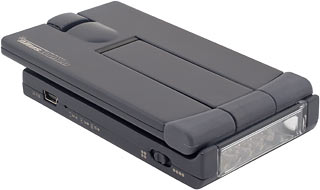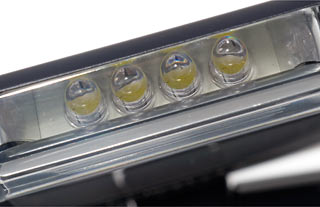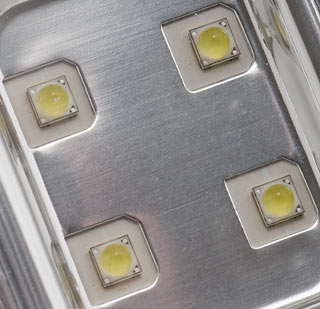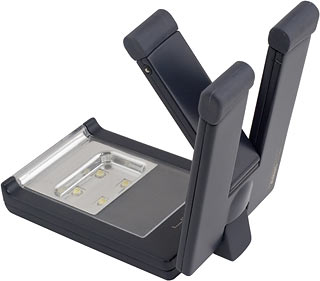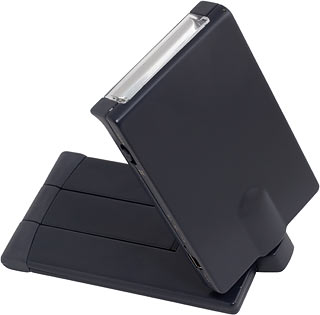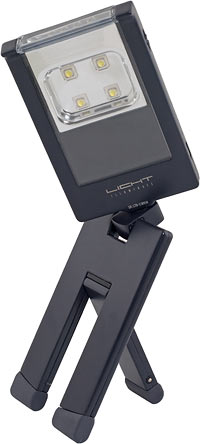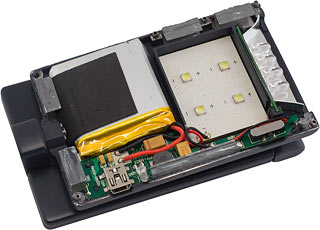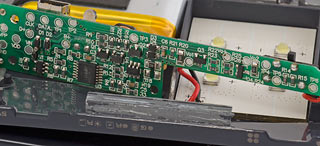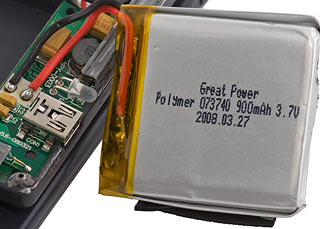
Altus Lumen Tri-L LED flashlight
Review date: 16 October 2008. Last modified 17-Sep-2013.
Less than ten years ago, LED flashlights were weird and exotic. Today, though, they're cheap supermarket items.
So one might reasonably wonder exactly how Altus Lumen think they're going to get away with making the Tri-L.
It's an LED flashlight that costs ninety-nine US dollars, plus six bucks shipping to, I think, anywhere in the world.
So, you know, it could be worse, but it'd have to be pretty darn special to justify the price.
Until recently, the Tri-L was being promoted as a "flashlight for engineers". Now, the Altus Lumen site has gone green all over, and they're raving about the product's "sustainability".
Stuff like this always makes me intensely suspicious.
Fortunately, though, you can safely ignore the goofy marketing. The Tri-L is quite a good product. For some people, it'll qualify as a very good product.
And for others, it won't.
More about that in due course.
What it does
Folded up, the Tri-L is a neat little package, a bit bigger than a pack of cards. It's about 106 by 60 by 19mm in size (4.2 by 2.4 by 0.75 inches), and weighs about 139 grams (4.9 ounces). It looks like some sort of cutting-edge solid-state camcorder, or part of Metal Gear Mk II.
It contains a rechargeable lithium-ion battery, two lights totalling eight LEDs, and one tripod.
The first light is the least interesting. It's these four 5mm white LEDs that peer out of the front of the package.
If you push the three-position switch on the side forward, the front LEDs light up and give you the same sort of medium-width beam that any number of $5 supermarket LED flashlights will also give you. It's good for seeing where you're walking, but it's nothing to get excited about.
The second light is much more impressive.
It uses four LEDs, again...
...but now they're four one-watt-class "super-LEDs", with an ultra-wide-angle work-light beam. It's these LEDs that make the Tri-L special.
When the Tri-L is folded up, the area-light LEDs are safe inside. But when you unfold it...
...the half with no electronics in it splits into a tripod, with...
...a swivel-hinge between it and the other half of the light, which allows you...
...to point the Tri-L in many different directions.
The fold-out middle leg of the tripod only seems to be meant to fold out one way, but if you fold it the other you won't hurt anything. And the leg only folds out so far, which along with the fact that the lamp part of the light is heavier than the tripod part means there are plenty of ways to set up the light so that it falls over rather than standing on its feet.
But these are the most minor of quibbles. It's easy to get the Tri-L's area light - or the front 4-LED flashlight, for that matter - to point pretty much anywhere you want it to. Even if you just want it to lie flat and shine straight up to light a room - just fold out the lamp, turn it around so the LEDs are on the outside rather than the inside, and fold it back again. It can't quite fold all the way back, but it's more than close enough.
I've been playing with the Tri-L for some time, now, and have used it in several work-light situations. It's easy to stand the light behind a computer or stereo system while you're trying to find which wire goes where, and it's bright enough that even if you're shining it on the wall behind the TV and not the TV itself, you'll probably still be able to read the tiny embossed connector labels.
The Tri-L also worked very nicely when I was grovelling around under the house trying to rat-proof a heating sensor. Not a pleasant job, but at least I could see what I was doing. And the beam's so wide that you don't have to jockey the light around to illuminate your whole work area.
I've also used the Tri-L as a humble reading light, parked next to my pillow and shining backward onto the white wall. The reflected light was more than bright enough, and very smooth; streets ahead of normal small reading lights, or improvised flashlight contraptions.
And, I remind you, the whole thing folds up small enough to fit in your pocket.
On the side of the light, there's a tiny status LED, a mini-USB socket for charging, and the light's only control - a slide switch to select spot, off, or area mode.
Spot mode works with the Tri-L folded up, but area mode doesn't, in a rather clever way.
Area mode wouldn't work with the light folded anyway, because the area-light LEDs are covered by the other half of the Tri-L then. But what actually happens is that the area-light LEDs don't even turn on if the switch is in that position but the light is still folded. And there's no battery drain, either - you can leave the Tri-L in area-light mode all the time, and just close it when you want it to turn off.
The secret to this magic trick is that there's a magnet built into one of the legs, and a matching reed switch in the head unit. When the magnet's close to the switch, it turns off area mode, but not spot mode. This is a very neat feature.
Charging
The mini-USB connector on the side of the Tri-L means you can charge it from any vaguely modern PC. It comes with a short USB lead for this purpose, plus a world-compatible mains-power-to-USB-socket adaptor which can be had with four different kinds of plug - though UK or Australian plugs cost an extra four dollars.
So you can charge the Tri-L anywhere there's a mains socket, or a computer. And if you drop a few dollars on eBay (or several dollars more at the Altus Lumen store) for a cigarette-lighter-to-USB power adapter, you can charge in the car, too
When the Tri-L's charging, the tiny LED on the side glows red; when the charge is complete it turns green. The LED also flashes red when the battery's getting low.
The charge process seems to take a leisurely three hours, no matter how flat the battery was when you started.
Brightness and power
LED brightness is often specified in "millicandelas", with many current LEDs well up into the whole-candela range. Millicandelas make the number more impressive, though, so your 10-for-five-bucks Chinese Photon-knockoff keychain flashlight will be billed as a "22000mcd!" item.
The candela, though, doesn't tell you how much light a device actually throws. Instead, it tells you how bright the light is over a particular solid angle. This has the advantage that the candela rating is the same no matter how far from the light you are, but if you focus the beam more tightly, you'll get a higher candela number.
This is how those cheap "1 million candlepower!" 12V spotlights work; they may actually have something close to that brightness, but their beam is very narrow. (A million candlepower is actually a perfectly respectable output figure for a lighthouse, which of course has a rather wider beam.)
To figure out how bright a light really is, you need to know how bright the beam is at a given distance, plus how wide it is.
The four-LED Tri-L "spot" beam is entirely unremarkable. The rectangular arrangement of the LEDs and their reflector (which does close to nothing with these conventional 5mm LEDs, but doesn't hurt) means the beam is noticeably oblong at less than a metre, smoothing out into the standard multi-LED cheap-flashlight blob at longer distances, with a bit more horizontal than vertical side-spill light.
The spot beam's about 20 degrees wide, and at one metre it peaked at about 100 lux. That's perfectly good for an everyday walking-around flashlight, but not much help if you want to see something at the top of a tree.
To make the Tri-L's brightness sound more impressive, Altus Lumen specify it at a distance of only half a metre, rather than the more usual one metre.
They say the area light manages 160 lux at half a metre. I measured it at half a metre and found it peaked at 215 lux, and was comfortably over 200 lux for the whole brightest middle portion of the super-wide beam. That beam is actually pretty close to a full 180 degrees wide; in a pinch I'd say the brightest area is confined to a mere 140 degrees or so, but there's useful spill light out to well over 170 degrees. So 160 lux might be a decent overall estimate.
160 lux overall, 215 lux peak at half a metre inescapably means 40 lux overall and only 54 lux peak at one metre. But that really is a lot for a beam this wide and a light this small. The threshold for human colour vision is down around one lux; the Tri-L's area light will manage better than that at six metres.
Again, this ain't much use for possum-spotting. But it does mean that you can light a whole room with this thing. Not, I grant you, as brightly as any normal lamp would, but way more brightly than you'd expect.
The area light also does a pretty spiffy job of showing you where you're going. There's no very natural-feeling way to hold it when you're walking around - it looks like a sci-fi prop, and not in a good way - but the whole area ahead of you is lit, to a quite useful distance. It's weird to not have to re-aim your flashlight to see different things.
The obvious question, at this point, is how long the light can keep pumping out this many photons per second. The answer, again according to the spec sheet, is eight hours for the boring spotlight mode, or 1.8 hours for area-light, from a full 90-minute charge.
I didn't do proper run-time measurements before, ahem, rendering them impossible - I'll get to that in a moment. But those numbers look reasonable enough to me. The Tri-L is made to handle long run times, too; high-powered LEDs need decent cooling if you're going to run them for any length of time, but the casing of the Tri-L seems to suck away the heat from the super-LEDs quite well.
The lithium-ion battery inside the Tri-L will, however, lose capacity over time, even if you hardly use the light. This is the one great limitation of lithium-ion technology. Current LiI batteries are rather better than they were when I wrote this, but you should still expect the battery in the Tri-L to be pretty much useless after no more than five years, and maybe as few as two.
But then you can just change the battery, right?
Well... maybe. Don't expect it to be easy.
Inside
Altus Lumen do not want you to look inside your Tri-L.
This was a bit rich, when their marketing was billing the light as being specifically "for engineers". If asked to name the market sector most likely to believe that if you can't open it, you don't own it, I'd say "engineers".
Engineers, hackers, and the few, the brave, the product reviewers with a wall full of tools in their office, are not fans of products with "no user-serviceable parts inside".
But the Tri-L I got for review was glued shut.
When I made clear to Altus Lumen that I was getting into the thing even if it, or possibly I, died in the attempt, one of their techs told me to cut around the parting line between the two case halves with a sharp knife.
I presume this was his idea of a merry jape, a little prank upon the newcomer. For lo, I did cut around the line, and yea, that was not really where the glue was, but verily, did I stab the battery with my hobby knife - because there's nothing at all between the battery and the parting line, on one side of the casing - and make a nice little spark.
I was, of course, lucky that this was all that happened. Lithium-ion cells are known for their complete lack of a sense of humour. They'll catch fire at the slightest provocation. But this one didn't.
At first, I thought I'd actually done no harm at all. The Tri-L was a bit temperamental until I'd given it another charge cycle, but then it seemed to work. Except, later on, it became clear that my Tri-L's run time is now only about 15 minutes in area-light mode.
So now I'm going to have to open it up again, after getting a new battery for it, if it's to be much use to me.
Aaaanyway, I did manage to get the bugger open. I clamped it into my vise and hammered a watch-case knife into each corner in turn, to bust the case open like a safecracker. When it was open, it was obvious that nothing short of this - or peeling it open with a specially-made dual-vise jig - could possibly have worked...
...because there's not just glue in the corners, but little metal roll pins as well, kind of dowelling the case together.
I appreciate that many of the lightweight, low-cost, high-performance electronic devices of today cannot be mass-produced without using case construction techniques that require a spudger for damage-free disassembly. But this is ridiculous.
Screws, guys. Seriously. They're a fascinating technology. Look into them.
The main circuit board's a pretty neat piece of restricted-shape miniaturisation. Like other "smart" LED flashlights, the Tri-L is controlled by a microcontroller, in this case a Microchip Technology PIC16F616. It has broadly similar capabilities to the CPU of an early-80s personal computer, but draws very little power and, in this case, has a chip package a scant five millimetres square.
Here is my poor little mortally-wounded battery. I think it's a pretty standard cell size, and bare lithium-ion cells are all over eBay these days, for people who want to resurrect PDAs or build small electric-powered model aircraft.
Altus Lumen have hard-soldered the battery wires to the Tri-L's circuit board, but this isn't much of a problem; the alternative would be to use some tiny plug and socket, which probably won't be available on cheap eBay batteries, so you'd have to snip the connector off and solder it onto the new cell anyway.
Just in case you were starting to feel relaxed about your chances of replacing the battery, though, note that there's an easy-to-misplace slip of plastic that stops the four front LEDs from shorting out on the casing. And when I got the light back together, I got the front-LED reflector slightly wrong. Since it does almost nothing anyway, I left it that way.
I know that most people will never even want to open their Tri-L. I've been carping on about this, though, because of what Altus Lumen did after they decided the Tri-L was not, in fact, for engineers.
Now, they say they "are working hard to make our products 100% sustainable". Recyclable parts, no toxic components, and apparently "Product manufacturing and use supports human rights, peace, human equity and culture diversity." I presume their flashlight's going to be winning a Nobel Peace Prize any day now.
All of this is nonsense, though, if you make a light with a battery that dies, and cannot easily be replaced. When that happens, your product will either end up in landfill or moulder in a drawer somewhere, the result for the environment being much the same in either case.
Altus Lumen told me they have a plan to deal with this: A lifetime free battery replacement guarantee.
Send a Tri-L with a dead battery back to them any time you like, and they'll replace the battery for free. You'll have to pay to send it to them, but the Tri-L is small and light so this shouldn't cost much.
Well, that's what they told me, anyway.
I expressed my concerns that it's possible that five years down the track they may have forgotten about this policy, or simply choose to no longer honour it (because, for instance, they just can't get the right size of battery any more), or might just have gone out of business (you know, all the same sorts of problems people have with games that require online activation). They told me that these fears were ungrounded. So there.
They also told me that information about this policy would soon be up on one or another of their Shipping and Returns pages.
It's been several weeks since they told me that, and no such information has appeared on their site. During this time, their warranty page has also stayed exactly the same. It's a standard one-year limited warranty, with no exceptions at all.
And even if they do suddenly decide to do what they promised me, there's bugger-all chance that a buyer of their products will remember the warranty terms some years down the line, unless said terms are engraved on the flashlight. And even if they started making such an engraving, there's still no guarantee at all that the policy will still be honoured some years from now.
I mean, I've got no evidence, beyond e-mails from their PR person, that they've even got such a policy now.
If they didn't keep raving on about how green and socially responsible and sustainable they were, I wouldn't much care about this.
(Apparently "The products are operated, produced and distributed by renewable energy"! I could have sworn that my review Tri-L was delivered by a fellow on a postie bike, but apparently I was mistaken.)
But they do make these claims, so I do care.
There's enough bloody greenwashing in the world already, guys.
(Altus Lumen have an external battery pack for the Tri-L that takes AAA cells. There are lots of other "USB power pack" gadgets on the market today which'd work with the Tri-L too. But that's lame; a Tri-L that's tethered to a battery box would be a lot less useful.)
Update
And wouldn't you know it, they did go out of business, not very long after I reviewed the Tri-L.
This review originally went up in mid-October, 2008.
Altus Lumen still existed in 2009, but in 2011 they were gone. Along with their guarantee. Do a Google search for Altus Lumen today and this page is hit number one. This review is the strongest remaining piece of evidence that the company ever existed.
I don't think they ever did actually put anything on their site about their super-duper lifetime guarantee. For all the good it'd do. By the time Tri-L batteries started failing in any quantity, there was no Altus Lumen to replace them.
The end of the original review follows, modified into the past tense.
Overall
The Tri-L was almost an awesome product. I loved it until I tried to open the bloody thing.
If you reckoned a hundred bucks was a reasonable price for a funky fold-up flashlight like this, and didn't mind the fact that despite Altus Lumen's green rhetoric the thing would probably be useless to you in a few years, you should have gone ahead and bought one. You'd have loved it.
But all this green bulldust just stuck in my craw. There were and are umpteen flashlights out there that aren't sold with any environmental claims at all, but are actually much "greener" than the Tri-L.
Look at the little Arc-AAA I reviewed several years ago, for instance. It's been my pocket flashlight for all of that time, and still works fine. I've touched up the solder-blob contact on the back of its lamp a couple of times, but that's all.
The Arc has, to be fair, gone through quite a few AAA batteries. But I'm using it with low self-discharge rechargeables, now. I used to use alkalines, so the battery wouldn't go flat just sitting in my pocket; that's not a problem any more.
Modern single-AAA lights from Peak or Fenix or the reborn Arc Flashlight can now thus all be very "green" indeed. There are plenty of bigger lights of which the same can be said, including umpteen "tactical" lights that used to have to run from disposable CR123 lithium cells, but can now use cheap rechargeable lithium-ion 123s.
Pretty much all of these lights are, however, conventional narrow-beam flashlights. If you want an area light, and you want it to last, then you're looking for a Tri-L-style wide-angle LED array and normal replaceable batteries.
Now, years after this review first went up, there are a million cheap LED lantern doohickeys on the market that use standard batteries. None of the cheap ones are as solid and sturdy as the Tri-L, but you can get ten spares for the same price.
I'm also happy to say that Altus Lumen had such a light. Sort of.
It was their "Pad-L", which was bulkier and less sexy than the Tri-L, and only an area light; it had no "spot" mode. But it was apparently brighter, and it ran from four AAA cells.
But I don't know if it ever actually went on sale.
(The same went for their giant "Ultra-Pro", which had thirty-six LEDs drawing a quoted ninety watts at full power, from ten D cells or an external power adapter.)
If Altus Lumen started selling the Pad-L, or making Tri-Ls that were user-serviceable and used a standard battery, or even just showed some signs of enacting the warranty policy they told me about, then I'd have cheerfully recommended their products. The Tri-L really was a very neat piece of gear.
But it was fatally flawed by its battery, and I'm quite happy to say that Altus Lumen paid the price for polluting the world with yet more "green" nonsense.
Review Tri-L kindly provided by Altus Lumen.
